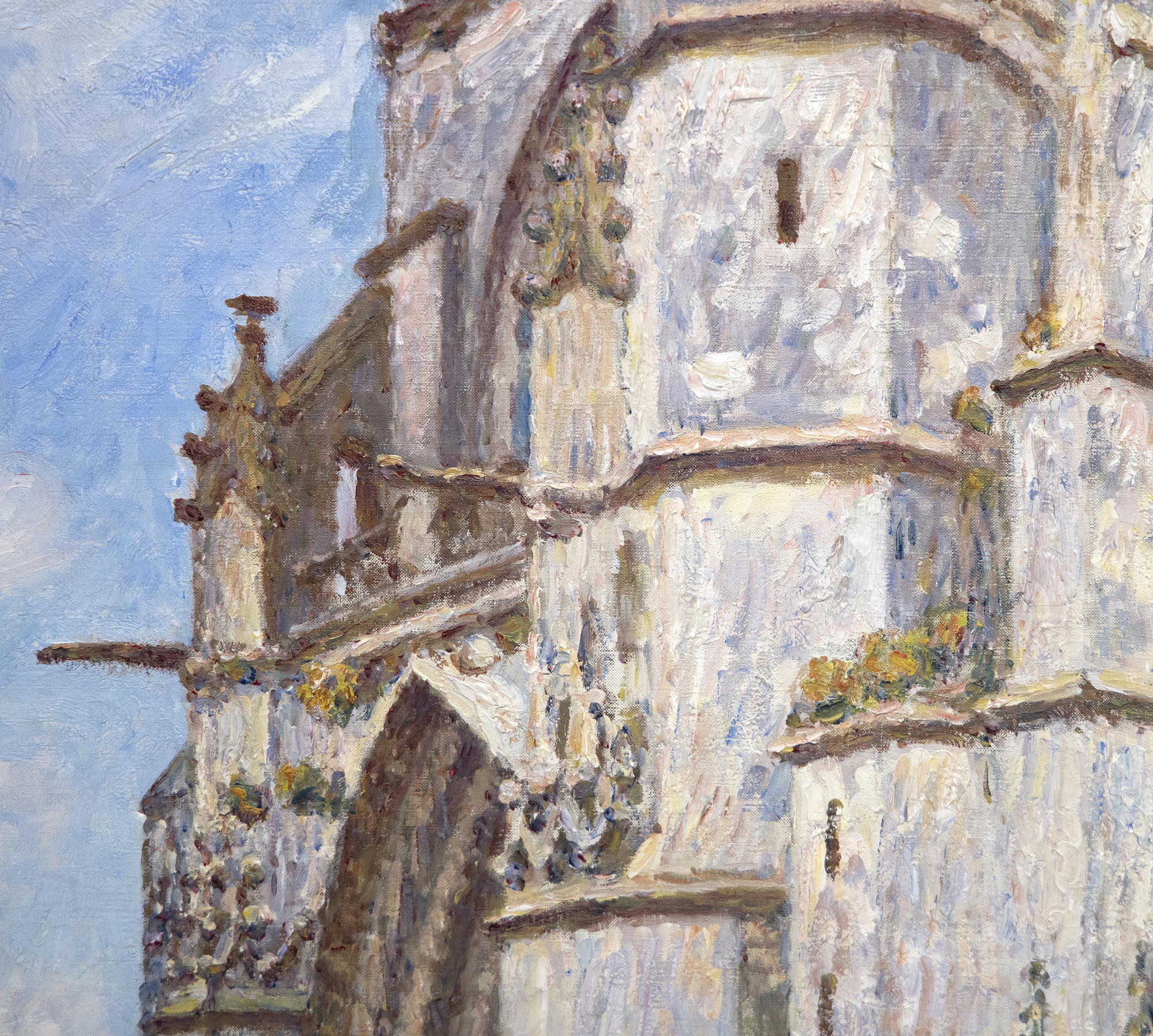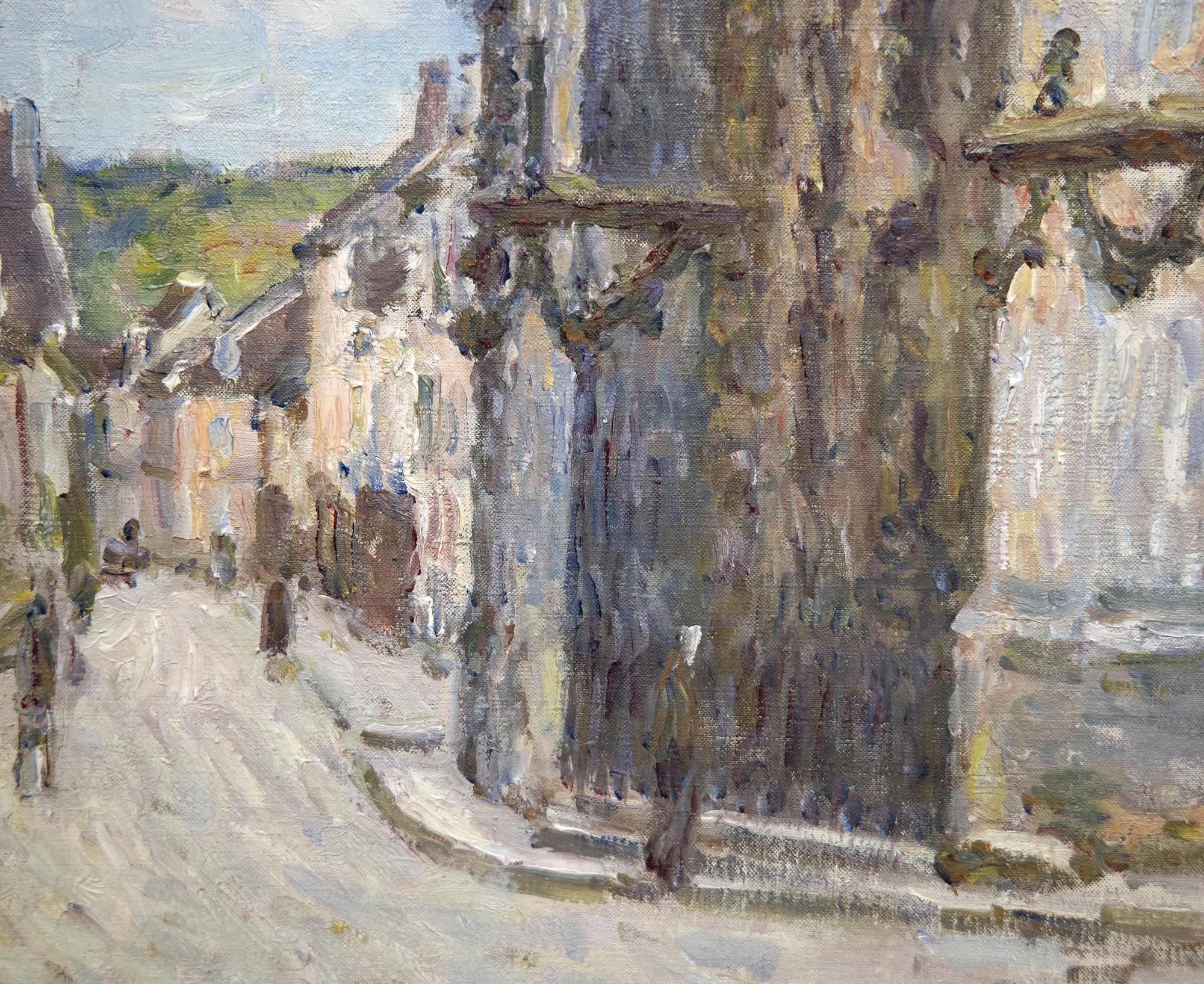Monets Serie der Kathedrale von Rouen gehört zu den berühmtesten Werken der Kunstgeschichte. Mehr als drei Jahre nach ihrer Entstehung Anfang Februar 1892 wurden zwanzig von Monets dreißig Gemälden der Kathedrale in der Galerie Durand-Ruel ausgestellt, und die Ausstellung wurde von den Besuchern im Mai 1895 mit überwältigender Mehrheit als ein Triumph angesehen. Unter den Malern schrieb Camille Pissarro, dass er "von ihrer außergewöhnlichen Geschicklichkeit hingerissen" sei. Cezanne, den [Pissarro] gestern bei Durand-Ruel getroffen hat, ist völlig einverstanden... dies ist das Werk eines ausgeglichenen, aber impulsiven Künstlers, der die nicht greifbaren Nuancen von Effekten verfolgt, die von keinem anderen Maler erreicht werden." (Camille Pissarro an seinen Sohn Lucien, 26. Mai 1895)
Monet war jedoch nicht so zuversichtlich, als er sein Vorhaben im April 1892 fortsetzte. Monet, der für seine Stimmungsschwankungen bekannt war, kehrte mit den ersten Kathedralenbildern nach Giverny zurück und war besorgt, dass es zu weit gehen könnte, das Licht und seine Wirkung auf die Form über alle bisherigen Vorstellungen hinaus zu übertreiben. Doch als er die Bilder den Besuchern präsentierte, reagierten diese mit ehrfürchtigem Staunen, und Monets Zuversicht wuchs. Das überschwängliche Lob des amerikanischen Malers Theodore Robinson entsprach der verblüfften Reaktion, die andere beim Anblick dieser Meisterwerke erlebten: "Sie sind einfach kolossal. Ich glaube, noch nie ist Architektur so gemalt worden, der erstaunlichste Eindruck von der Sache, ein Gefühl von Erhabenheit und Verfall...nirgends eine Linie - und doch ein wunderbares Gefühl von Konstruktion und Solidität. Ist es nicht merkwürdig, dass ein Mann ein solches Material nimmt und es so großartig einsetzt?" (Robinson an J. Alden Weir, Mai 1892)
Könnte Alfred Sisley zu den ersten Kathedralenhelfern gehört haben? Auf jeden Fall. Monet und er waren die engsten Freunde. Sisley war zwar ein privater, stiller Mann, der nur wenige biografische Spuren hinterließ, aber er war auch eine äußerst vertrauenswürdige Quelle und ein Künstler, den Monet sehr respektierte. Tatsächlich bestätigen Berichte aus erster Hand von Sisley und Monets Weggefährten die Verbindung zwischen den beiden Serien. In einem Tagebucheintrag vom 21. September 1893 von Julie Manet (der damals jugendlichen Tochter von Berthe Morisot und Edouard Manets Bruder Eugéne) heißt es: "Nach einem regnerischen Morgen wurde der Tag sonnig, und wir fuhren nach Moret hinaus... Wir sahen Sisley." Ihr Sohn, der Kunsthistoriker Denis Rouart, bestätigt diesen Eintrag und führt weiter aus, dass "Berthe und ihre Tochter... mit den Mallarmés nach Moret fuhren, wo Sisley eine Reihe von Kirchen malte - inspiriert, so dachte Mallarmé, von Monets Serie der Kathedralen." (Denis Rouart, Paris, 1950)
Alfred Sisley hatte sich im November 1889 in Moret-sur-Loing niedergelassen, einem Dorf mit unvergleichlichem Charme zwischen der île-de-France und Burgund am Rande des Waldes von Fontainebleau. Zu seinen attraktivsten Merkmalen gehört die imposante Kirche Norte-Dame im gotischen Stil, die vom Fluss aus die Silhouette dominiert. Von Sisleys bescheidenem Garten aus war der Turm der Kirche ein allgegenwärtiges Merkmal der Skyline.
Im Gegensatz zu Monet, dessen dreißig Ansichten des Portikus der Kathedrale von Rouen auf der Westseite ausschließlich als Untersuchung des Licht- und Schattenspiels auf der Fassade des Gebäudes ausgeführt wurden, versuchte Sisley, den dauerhaften Charakter der Kirche unter den wechselnden Lichtverhältnissen und Stimmungen, die er in seinen Gemälden festhielt, zu bestätigen. Unter den Impressionisten war er derjenige, der am liebsten im Freien arbeitete, ohne sich für Änderungen oder Ausbesserungen in ein Atelier zurückzuziehen. Der stille und zurückgezogene Sisley arbeitete an seinen Kathedralen, wie er es immer getan hatte, alla prima und ausschließlich en plein air, um das wechselnde Aussehen eines Motivs durch eine Reihe von atmosphärischen Veränderungen zu zeigen. Dass er den Werken Titel wie "Im Sonnenschein", "Unter Frost" und "Im Regen" gab und sie 1894 im Salon du Champ-de-Mars als Gruppe ausstellte, deutet darauf hin, dass er sie auch als serielle Interpretationen betrachtete.
Sisley wurde oft für seine sanfte Integrität und seine Fähigkeit, Atmosphäre und Ton wahrheitsgetreu wiederzugeben, gelobt, aber er war auch in der Lage, kraftvoll strukturierte Kompositionen zu schaffen und zeichnete sich durch die Darstellung von Szenen aus ungewöhnlichen Blickwinkeln aus, die seine Kompositionen belebten. Es überrascht nicht, dass L'Église de Moret, le Soir ein hervorragendes Beispiel dafür ist, wie Sisley seine Staffelei vorteilhaft einsetzte. Seine Blickrichtung ist leicht nach oben geneigt, aber eindeutig auf die südwestliche Säulenecke gerichtet. Diese gebündelte Säule unterstreicht die imposante, nach oben gerichtete Ausrichtung des Kirchenmotivs. Die eigentliche Kunst besteht jedoch darin, dass sie als Zentrum fungiert, von dem aus sich zwei Spannungskräfte mit überraschenderweise angemessener Kraft voneinander entfernen. Die Brillanz dieses Gemäldes liegt in der dramatischen Wirkung der abfallenden Perspektive, die durch die schmale Straße (rue de l'Église) auf der linken Seite entsteht, und der verschwommenen Opposition, die ein steinernes Bauwerk von unvorstellbarem Gewicht und unvorstellbarer Masse darstellt; beides sind flächige Aspekte, die perfekt ausgearbeitete, abnehmende Dreipunktperspektiven demonstrieren.
Von dem Dutzend bekannter Ölgemälde, die Sisley von der Kirche von Moret gemalt hat, ist L'Église de Moret, le Soir nicht nur von großzügiger Größe, sondern gehört auch zu den größten Gemälden seines Gesamtwerks. Das Ausmaß dieses Werks zeigt Sisleys Entschlossenheit, eine Hommage zu schaffen, die den Architekten und Erbauern eines Bauwerks, das so uneinnehmbar und entschlossen ist, dass es zur Zeit, als Sisley es malte, noch genauso stand wie im Mittelalter, und das für uns heute so steht, wie es in alle Ewigkeit stehen wird, voll und ganz respektiert.
Fragen SieKunst-Detail
ALFRED SISLEY (1839-1899)










Provenienz
Anwesen SisleyVerkauf: Vente de l'Atelier Sisley, Galeries Georges Petit Paris, 1. Mai 1899, Los 13
George Viau, Paris
Verkauf: Hôtel Drouot Paris, 20. Februar 1908, Los 37
Sammlung Pearson, Paris (erworben bei der oben genannten Versteigerung)
Versteigerung: Vente Pearson, Galerie Paul Cassirer Berlin, 18. Oktober 1927, Los 65
Privatsammlung
Verkauf: Hôtel Drouot, Paris, 23. Juni 1928, Los 98
Sammlung Aubert, Paris (erworben bei der oben genannten Versteigerung; möglicherweise Marcel Aubert)
Privatsammlung Galerie Edward Nahem
S...Mehr.....teven Bedowitz, Boca Raton, Florida (erworben 1989)
Privatsammlung, New York
Larry Lacerte, Dallas (erworben im Jahr 1991)
Privatsammlung (erworben 1996)
Ausstellung
Tokyo, Isetan Museum of Art; Kagawa, Takamatsu Municipal Museum of Art; Hiroshima, Museum of Art und Wakayama, Departmental Museum of Modern Art, Exposition Alfred Sisley, 2000, Nr. 53, illustriert in Farbe pp. 138-139Literaturhinweise
O. Reuterswaerd, 'Sisley's Cathedrals, A Study of the Church at Moret' in Gazette des Beaux Arts, März 1952, Abb. 1, illustriert S. 194F. Daulte, Alfred Sisley. Catalogue raisonné de l'œuvre peint, Lausanne, 1959, Nr. 835, schwarz-weiß illustriert
F. Daulte, Sisley. Les Saisons, Paris, 1992, Nr. 41, abgebildet in Farbe S. 73
R. Shone, Sisley, New York, 1992, Abb. 134, farbig illustriert S. 170 (erwähnt S. 164-165)
Brame, S., Sisley, A., Lorenceau, F., & Daulte, O. (2021). Alfred Sisley: Catalogue critique des peintures et des pastels. S. 347 ill. 347, 501
...WENIGER.....
Dennoch bemühte sich Sisley, die wechselnde Erscheinung des Motivs durch eine Reihe von atmosphärischen Veränderungen zu zeigen. Er gab den Werken Titel wie "Im Sonnenschein", "Unter Frost" und "Im Regen" und stellte sie 1894 im Salon du Champ-de-Mars als Gruppe aus, was darauf hindeutet, dass er sie als serielle Interpretationen betrachtete. Im Gegensatz zu Monets Werk l'église de Moret zeigt le Soir jedoch, dass Sisley das Motiv in einem räumlichen Kontext darstellte, der seine kompositorischen Attribute hervorhebt - die abfallende Perspektive der schmalen Straße links, der starke diagonale Rücksprung der Gebäudelinien als Gegengewicht auf der rechten Seite und das imposante Gewicht des steinernen Gebäudes oberhalb der Sichtlinie.

















